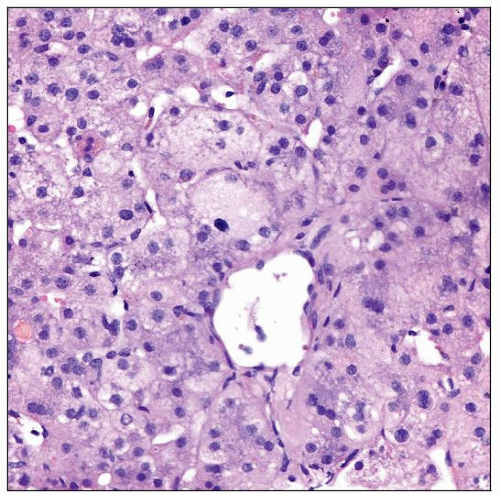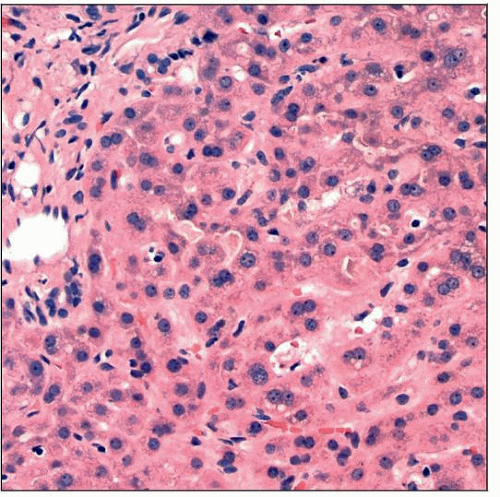Progressive Familial Intrahepatic Cholestasis
Joseph Misdraji, MD
Key Facts
Etiology/Pathogenesis
PFIC1 is due to mutations of ATP8B1 (FIC1 gene)
PFIC2 is due to mutations of ABCB11 gene that encodes bile salt export pump (BSEP)
PFIC3 is due to mutations of ABCB4 gene that encodes MDR3, a phospholipid floppase
Clinical Issues
PFIC presents in 1st year of life with intense pruritus and jaundice
PFIC1 and PFIC2 are characterized by normal serum GGT whereas PFIC3 is associated with elevated GGT
Progressive forms lead to liver failure, cirrhosis, and death before adulthood
Partial external biliary diversion or ileal exclusion may be used with some success, but most patients require liver transplantation
Microscopic Pathology
Histologic overlap between the 3 types of PFIC and with other causes of intrahepatic cholestasis
PFIC1 is characterized by canalicular cholestasis with limited giant cell transformation and compact hepatocytes
PFIC2 is characterized by pattern of neonatal giant cell hepatitis
PFIC3 is characterized by obstructive pattern with duct proliferation and bile plugs in ductules
Ancillary Tests
FIC1 disease reveals coarse, granular bile on electron microscopy, referred to as Byler bile
Absence of staining for canalicular proteins by immunohistochemistry can be diagnostic
 Hematoxylin & eosin-stained section of a liver biopsy in a child with PFIC shows giant cell transformation of perivenular hepatocytes, typical of childhood cholestasis syndromes. |
TERMINOLOGY
Abbreviations
Progressive familial intrahepatic cholestasis (PFIC)
Definitions
Heterogeneous group of autosomal recessive disorders characterized by chronic cholestasis and progression to cirrhosis and liver failure
PFIC type 1 (PFIC1)
Familial intrahepatic cholestasis 1 (FIC1) disease
Byler disease
Greenland familial cholestasis (GFC)
PFIC type 2 (PFIC2)
Bile salt export pump (BSEP) disease
Byler syndrome
PFIC type 3 (PFIC3)
Multidrug resistance protein 3 (MDR3) disease
Benign recurrent intrahepatic cholestasis (BRIC)
Caused by mutations in FIC1
ETIOLOGY/PATHOGENESIS
Autosomal Recessive Genetic Disorder
PFIC1
Mutation of ATP8B1 (FIC1 gene), located on chromosome 18q21-q22
FIC1 is expressed in several tissues including canalicular membrane of hepatocyte, enterocytes, pancreas
Functions as aminophospholipid flippase, flipping phosphatidylserine from outer to inner lipid layer of cell membrane
Mechanism of cholestasis unclear but may be related to membrane instability, decreased BSEP function, or downregulation of cystic fibrosis transmembrane conductance regulator (CFTR)
PFIC2
Mutations of ABCB11 gene on chromosome 2q24 that encodes BSEP, an ATP-dependent bile acid transporter on canalicular membrane
D482G mutation results in abnormal but not absent protein and less severe disease
PFIC3
Mutation of ABCB4 gene that encodes MDR3 glycoprotein
MDR3 is floppase that flips phosphatidylcholine from inner to outer lipid leaflet of canalicular membrane
Phosphatidylcholine in bile reduces its detergent action, and MDR3 deficiency results in bile with more detergent properties
Absence of phospholipids destabilizes micelles, promoting lithogenicity of bile with crystallization of cholesterol and leading to small bile duct obstruction
CLINICAL ISSUES
Presentation
FIC1 deficiency disease
Depending on nature of mutation, may present as benign recurrent intrahepatic cholestasis (BRIC1) or progressive and severe form (PFIC1)
Heterozygous mutations identified in some cases of transient neonatal cholestasis and cholestasis of pregnancy
PFIC1
Presents in neonatal period with intense pruritus and jaundice
Extrahepatic manifestations include short stature, pancreatitis, diarrhea, deafness, respiratory issues, and elevated sweat chloride concentration
BRIC1
BSEP disease
Depending on nature of mutation, may present as BRIC2 or PFIC2
Heterozygous mutations identified in cholestasis of pregnancy, drug-induced cholestasis, and transient neonatal cholestasis
PFIC2
Presents as severe intrahepatic cholestasis in infancy
BRIC2
Presents as recurrent episodes of pruritus, steatorrhea, nausea, vomiting, anorexia, right upper quadrant abdominal pain, and weight loss
Frequently complicated by cholesterol cholelithiasis
MDR3 disease
PFIC3 may present in infancy, childhood, or even adulthood
In infancy, presents with less intense pruritus than PFIC1 or PFIC2 and, in later years, as complications of portal hypertension such as gastrointestinal bleeding
Heterozygous mutations identified in patients with intrahepatic lithiasis, cholesterol gallstone disease, cholestasis of pregnancy, transient neonatal cholestasis, cholestatic drug reactions, adult idiopathic cirrhosis, cholangiocarcinoma
Laboratory Tests
GGT
Normal in PFIC1 and PFIC2, elevated in PFIC3
Elevated serum bile acids and normal cholesterol in all 3 types
PFIC3 is characterized by low concentrations of phospholipids in bile analysis
Natural History
Progressive forms can result in worsening hepatic function, liver failure, cirrhosis, and death before adulthood
BSEP deficiency more likely to progress to cirrhosis
Fat malabsorption may result in fat-soluble vitamin deficiencies, with coagulopathy, rickets, or seizures
BSEP disease is associated with development of hepatocellular carcinoma
Treatment
Surgical approaches
Partial external biliary diversion or cholecystojejunocutaneostomy
Short jejunal segment is anastomosed to the dome of gallbladder and terminates as stoma, allowing bile to be discarded
Ileal exclusion
˜ 15% of terminal ileum is bypassed, which reduces bile acid reabsorption
Liver transplantation
May result in intractable diarrhea and steatohepatitis in FIC1 deficiency
Recurrence of disease in allograft reported in BSEP deficiency
Drugs
Ursodeoxycholic acid (UDCA), rifampin, cholestyramine, and phenobarbital have been used to treat pruritus
MICROSCOPIC PATHOLOGY
Histologic Features
Histologic overlap between the 3 types of PFIC and with other causes of intrahepatic cholestasis
Stay updated, free articles. Join our Telegram channel

Full access? Get Clinical Tree



